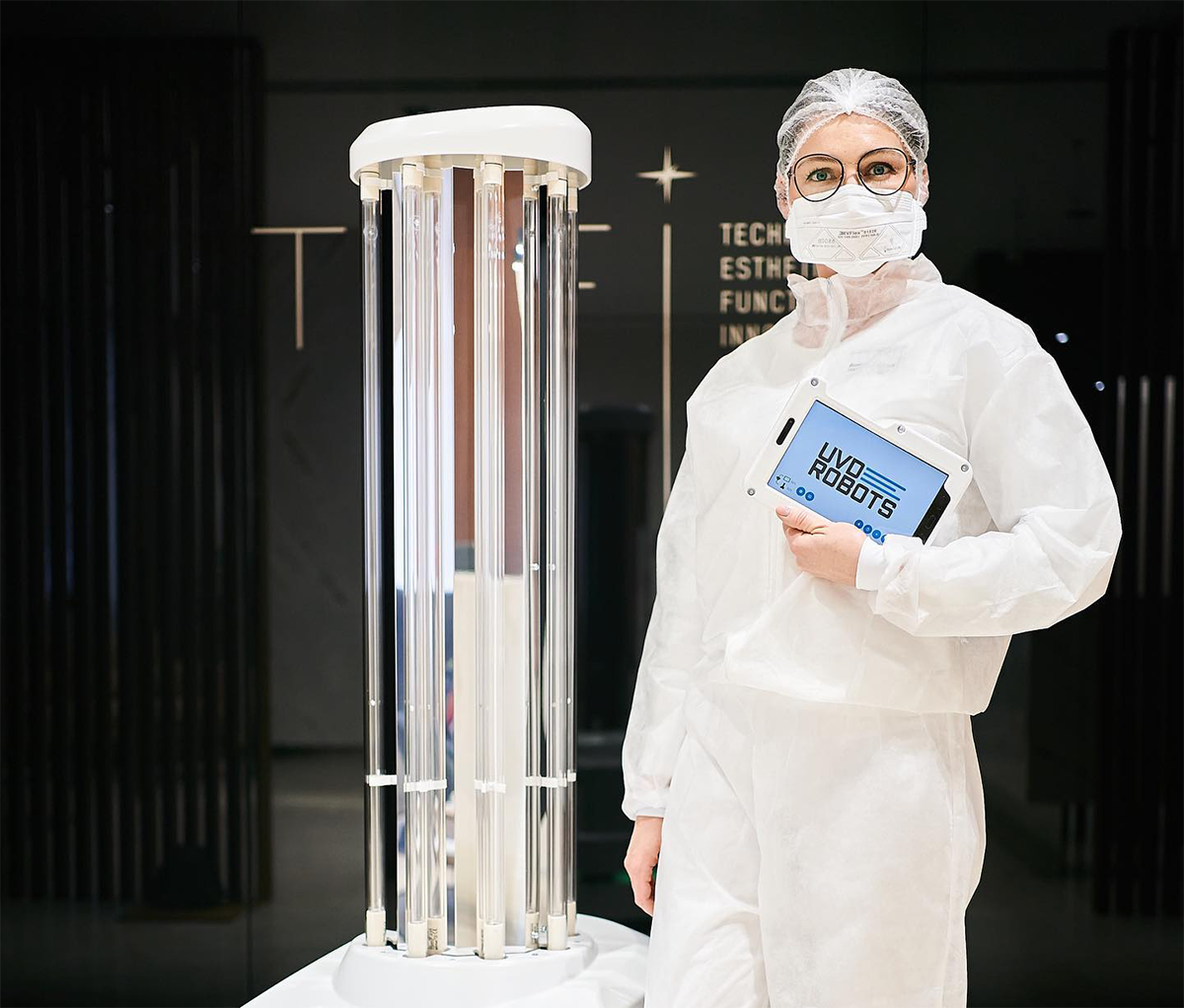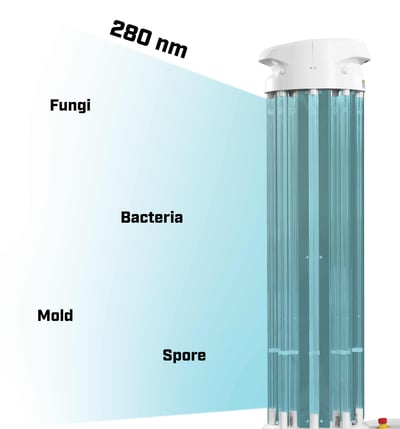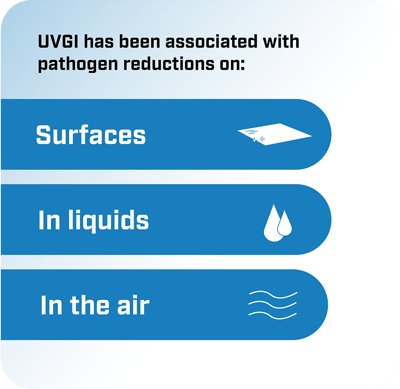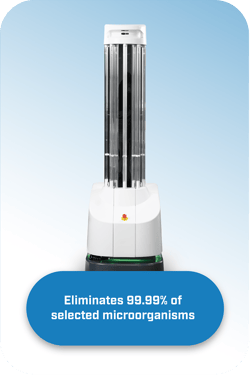Title
Content
Title
Content

Environmental disinfection methods involving ultraviolet (UV) light have been found to be highly effective against significant microorganisms, but they can differ in something known as UV dose. The following is a closer look at UV doses and their effects.
Ultraviolet light – also known as UV light – is a form of radiation found on the electromagnetic spectrum. UV light has wavelengths that range from 100 to 400 nanometers (nm) and unlike visible light, can not be distinguished by the unaided human eye.1
 UV light comes in different forms, but UV-C light, with a wavelength of 200 to 280 nm2 is especially noted for its association with:
UV light comes in different forms, but UV-C light, with a wavelength of 200 to 280 nm2 is especially noted for its association with:
UV-C light with wavelengths of 254 nm is also sometimes referred to as Ultraviolet Germicidal Irradiation, or UVGI. UVGI’s effects on bacteria and its surroundings is not always uniform, however, this depends on something called UV dose.
UV dose is defined as the amount of UV radiation projected from all directions onto the surface of an extremely small sphere, divided by the area of a cross-section of that sphere.4 5 Also known as fluence, UV dose can be expressed in terms of millijoules per square centimeter (mJ/cm2).
Since the effects of UV doses are measured in relation to exposure times, UV dose units are often multiplied by exposure time, represented by t.6 Generally, the greater the exposure time, the more profound the effects of UV dose will be on microorganisms and environmental materials.7 8
When it comes to using UVGI in the realm of environmental disinfection, UV doses affect their surroundings in two significant ways.
Firstly, a UV dose has been associated with an impact on microorganisms in a given environment. Secondly, depending on exposure times, UV doses can affect environmental materials as well. Both of these effects can differ considerably between static and autonomous UVGI disinfection methods. 
UVGI has been associated with microorganism reductions:
UV disinfection methods for indoor environments can include use of either static or mobile, autonomous (or self-navigating) methods. Methods that involve static disinfection tools typically consist of a free-standing unit that emits UV light in a room over long periods of time.13 These methods typically prolong a room’s exposure to a UV dose, and increase the chances for material degradation.14 15
Autonomous UV disinfection methods, however, typically involve machines that are self-driving and emit UV doses to many areas in a disinfection session. As autonomous units are highly mobile when compared to static machines, they typically can expose environments to UV doses for comparatively much shorter durations.19 This limits the chances of potential material degradation provoked by prolonged UV dose exposure.16

UVD Robots (short for Ultraviolet Disinfection Robots), are self-driving UVGI disinfection robots pioneered by Blue Ocean Robotics, a Danish company that specializes in developing professional robotic solutions.
As autonomous units, UVD Robots are self-navigating and highly mobile, reducing the risk of prolonged UV dose exposure to indoor environments. They are additionally capable of reaching shadowed areas of rooms, and, in comparison with their static counterparts, able to cover greater distances for disinfection.
These robots have also been associated with eliminating microorganisms at elevated efficacy rates.17 They are capable of emitting UVGI associated with eliminating microorganisms, at a 4-log reduction, or a rate of 99.99%.18
In conclusion, UVD Robots provide an efficient reduction of UV dose exposure times, and offer better rates of disinfection efficacy. This technology works with an understanding of UV doses and environments, to provide higher efficacy in disinfection.
Lorem ipsum dolor sit amet, consectetur adipiscing elit, sed do eiusmod tempor incididunt ut labore et dolore magna aliqua.
1. BELULİ, Valdrin. "Intermediate Formation of Essential Amino Acids and Division of Amine (NH2) Group by UV Light as Sterilizer in Vegetables (ISO 15714: 2019)." Journal of Nuclear Sciences 6.2 (2020): 34-43.
2. Illuminating Engineering Society. “IES Committee Report CR-2-20 FAQs.” Illuminating Engineering Society, 7 Mar. 2022, www.ies.org/standards/committee-reports/ies-committee-report-cr-2-20-faqs.
3. Kujundzic, Elmira, et al. "UV air cleaners and upper-room air ultraviolet germicidal irradiation for controlling airborne bacteria and fungal spores." Journal of Occupational and Environmental Hygiene 3.10 (2006): 536-546.
4. Bolton, James R., Ian Mayor‐Smith, and Karl G. Linden. "Rethinking the concepts of fluence (UV dose) and fluence rate: the importance of photon‐based units–a systemic review." Photochemistry and Photobiology 91.6 (2015): 1252-1262.
5. Bolton, James R., and Karl G. Linden. "Standardization of methods for fluence (UV dose) determination in bench-scale UV experiments." Journal of environmental engineering 129.3 (2003): 209-215.
6. Bolton, James R., Sara E. Beck, and Karl G. Linden. "Protocol for the determination of fluence (UV dose) using a low-pressure or low-pressure high-output UV lamp in bench-scale collimated beam ultraviolet experiments." IUVA News 17.1 (2015): 11-16.
7. Chen, Peng-Fei, et al. "UV dose effects on the revival characteristics of microorganisms in darkness after UV disinfection: evidence from a pilot study." Science of the Total Environment 713 (2020): 136582.
8. Sung, Lipiin, et al. "A quantitative study of nanoparticle release from nanocoatings exposed to UV radiation." Journal of Coatings Technology and Research 12.1 (2015): 121-135.
9. Olagüe, Cristina, et al. "Rapid SARS-CoV-2 disinfection on distant surfaces with UV-C: The inactivation is affected by the type of material." Journal of Photochemistry and Photobiology 11 (2022): 100138.
10. Mok, Chulkyoon, and Nam-Hoon Lee. "Ultraviolet inactivation of Escherichia coli in stainless steel cups." Food Engineering Progress 13.2 (2009): 122-129.
11. Kuo, Mon-lin, and Ninghe Hu. "Ultrastructural changes of photodegradation of wood surfaces exposed to UV." (1991): 347-353.
12. Martínez de Alba, Angel Emilio, et al. "Microbiological evaluation of the disinfecting potential of UV-C and UV-C plus ozone generating robots." Microorganisms 9.1 (2021): 172.
13. M Rus, Anika Zafiah, A. Shahrizan Syah, and Farhana Hazwanee MJ. "Mechanical properties of wood polymer composites (WPCs) after prolonged ultra-violet (UV) irradiation exposure." International Journal of Engineering and Technology 7.3.28 (2018): 258-260.
14. Javier, Carlos, et al. "Effect of prolonged ultraviolet radiation exposure on the blast response of fiber reinforced composite plates." Journal of Materials Engineering and Performance 28 (2019): 3174-3185.
15. Mehta, Ishaan, et al. "UV disinfection robots: A review." Robotics and Autonomous Systems (2022): 104332.
16. Teacă, Carmen-Alice, et al. "Structural Changes in Wood under Artificial UV Light Irradiation Determined by FTIR Spectroscopy and Color Measurements--A Brief Review." BioResources 8.1 (2013).
17. Mehta, Ishaan, et al. "UV disinfection robots: A review." Robotics and Autonomous Systems (2022): 104332.
18. Mehta, Ishaan, et al. "UV disinfection robots: A review." Robotics and Autonomous Systems (2022): 104332.